20 Types of Ducks in Minnesota (With Pictures)
Last Updated on
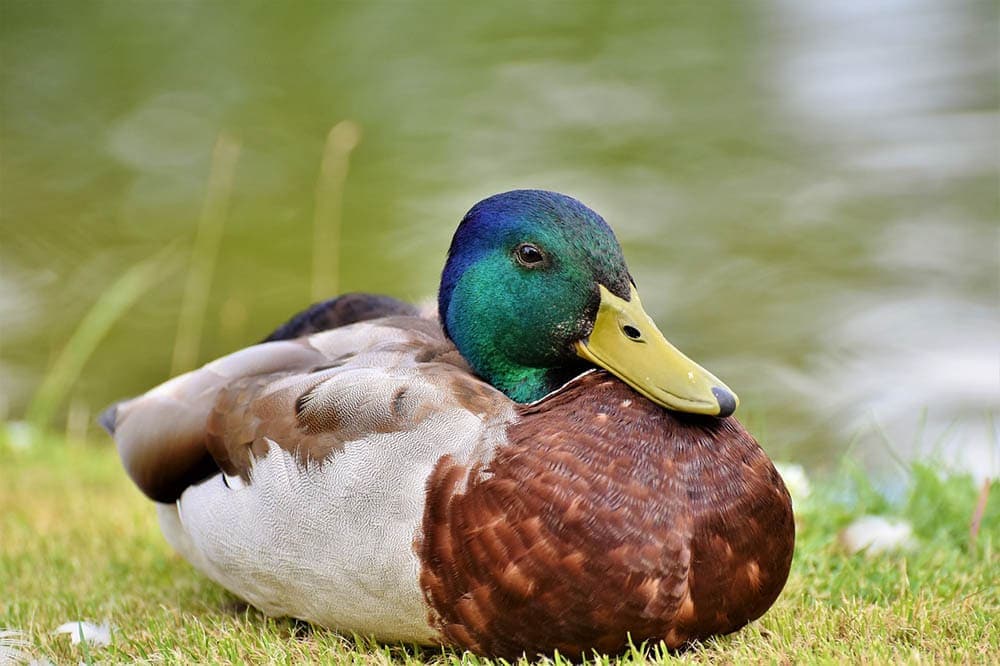
All ducks are part of the Anatidae family of birds. The common denominator is water. These species depend on water for some or all their lives. They live across the globe, except Antarctica. These birds are usually migratory, seeking out warmer areas where water may freeze over during the winter. There are two primary groups based on their feeding pattern, dabblers or puddle ducks and divers.
That distinction often extends to the duck’s behavior. Some species, such as Mallards, are indeed tolerant of humans and will live alongside them in urban and rural areas. Others, like American Goldeneyes, are quite flighty. You’d be lucky to get close to these ducks. Other than behavior, the color of the wing coloration, flight pattern, and even the sound of their wings in flight can help ID them.

The 20 Duck Breeds found in Minnesota
1. Mallard (Anas platyrhynchos)
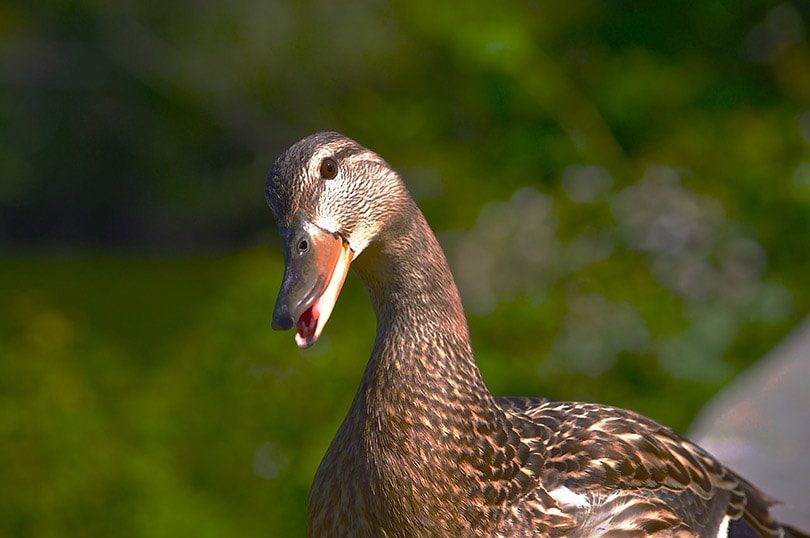
The Mallard is probably the duck that comes to mind when we mention this bird. One of the primary reasons for this species’ success is adaptability. It can live in just about any wetland habitat. It also grows accustomed to the presence of humans. The Mallard is an opportunistic bird that will eat whatever vegetation it can find.
2. Wood Duck (Aix sponsa)
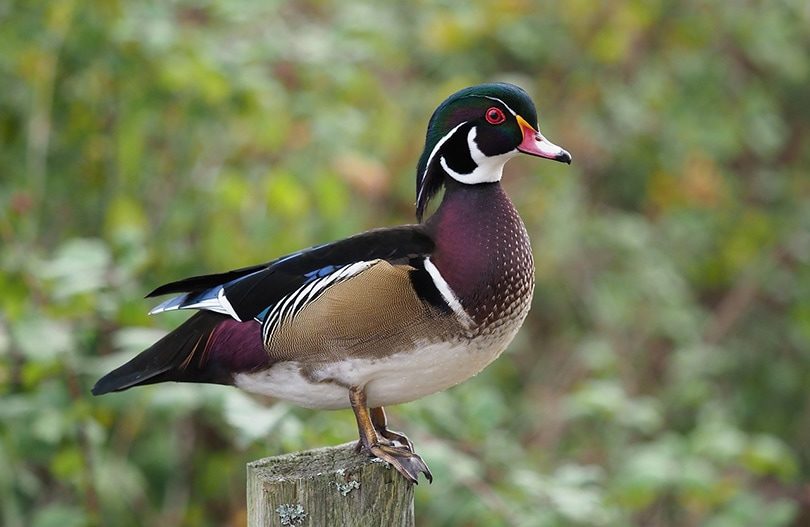
The Wood Duck is an attractive bird with the striking swept-back crested and interesting facial markings of the male. This species breaks the mold about what you may think about ducks. It will perch in trees and often feed on acorns in the fall. You’re likely to find the Wood Duck in wetlands or forests. Like the Mallard, its numbers are increasing.
3. Gadwall (Mareca strepera)
https://www.instagram.com/p/CYE1tF-pQOl/
Unlike the previous two species, the Gadwall is a plain-looking bird with drab coloration that provides excellent camouflage in cattail marshes. It is found throughout North America and across the pond in Europe and Asia. The female is a vocal duck, whereas the male is quieter, making its characteristic whistling call.
4. Northern Pintail (Anas acuta)
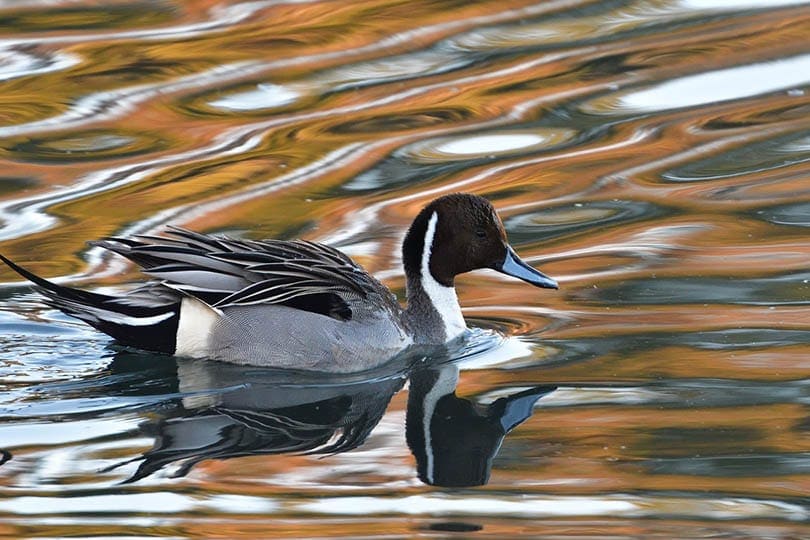
The Northern Pintail is an omnivorous duck that will occasionally feed on amphibians, invertebrates, and even fish. It prefers wetlands associated with prairies and grasslands. It gets its name from the white point on the male’s neck. Hunting pressure and habitat degradation have taken a toll on this species, causing its numbers to drop in recent years.
5. Blue-Winged Teal (Spatula discors)
https://www.instagram.com/p/CYRdG-iLO1G/
The Blue-Winged Teal gets its name from the distinctive blue patch on its wings. It’s another vocal duck that is usually the first to migrate in the fall and the last species to return in the spring. You can easily spot this bird by its erratic flight. The male also sports a white crescent marking in front of its eyes.
6. Green-Winged Teal (Anas carolinensis)

The Green-Winged Teal is truly a northern bird, migrating as far north as Alaska. If there is open water, you’re likely to see this duck. It is one of Minnesota’s smallest waterfowl. Its numbers have increased in recent years, due in part to its adaptability. This bird lives in a wide variety of habitats, from shrublands to marshes to marine coastlines.
7. Cinnamon Teal (Spatula cyanoptera)

The Cinnamon Teal lives in the wetlands of North and South America. It gets its name from the chestnut-colored body and striking red eyes of the male. While they prefer wetlands, you’ll also find these birds swimming in streams and open ponds. It is an omnivore that will feed on whatever it can find. Like the Northern Pintail, its numbers have been decreasing in the last 40 years.
8. Northern Shoveler (Spatula clypeata)

It’s easy to spot a Northern Shoveler by its large, conspicuous bill. Its coloration resembles a Mallard, although it’s a bigger duck. It has a series of pin-like projections protruding along the perimeter of its beak to filter food. Unlike many dabblers, this species is monogamous. While you’ll see this bird across the country, it primarily breeds in northern areas, such as Minnesota.
9. American Black Duck (Anas rubripes)
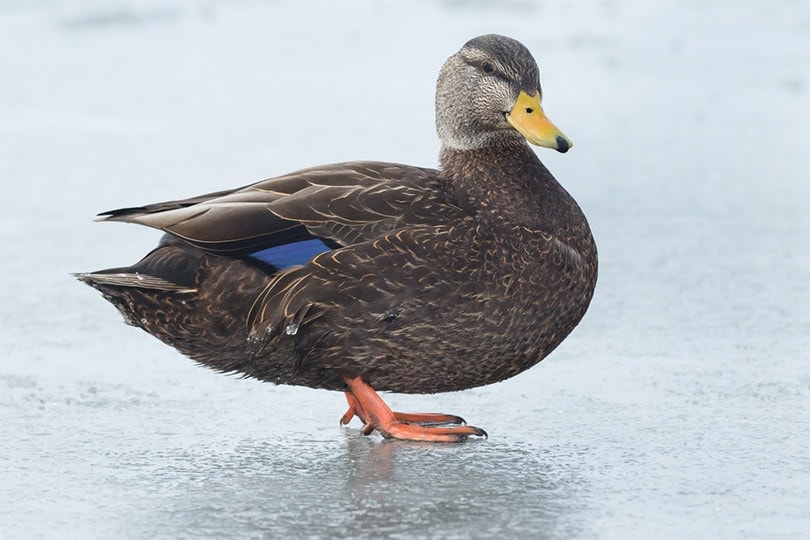
Minnesota is on the western edge of the American Black Duck’s range in the United States, where it is a year-round resident in the state. Its name is something of a misnomer since it’s slate gray instead. Unfortunately, this bird’s population is decreasing, primarily due to habitat loss and hunting. However, this duck occasionally shows up in Europe.
10. American Widgeon (Mareca americana)
https://www.instagram.com/p/CYPdpBavWQJ/
The American Widgeon is easy to identify, with its green stripe starting at its eyes and the white one going along the top of its head. The latter is one reason why you may see this bird called Baldpate. It is a wary duck that will flush quickly if it hears anyone approaching it. You can spot it from a distance or listen for its signature nasal whistle.
11. Lesser Scaup (Aythya affinis)

You’re most likely to spot a Lesser Scaup during its migration north to its breeding grounds. The peaked head and front of its body are black, which provides a stark contrast with its bright, yellow eyes. It also has a black stripe on its silver-gray bill. It is a diving duck that will go deep to find crustaceans and other animal matter to eat.
12. Greater Scaup (Aythya marila)

The behavior and feeding habits of the Greater Scaup are similar to the previous species. It is also a northern bird that only passes through Minnesota. Its numbers are in steep decline because of renewable energy production and oil drilling that impact its habitat. It is larger and has a rounded head versus the unique shape of the Lesser Scaup.
13. Common Goldeneye (Bucephala clangula)

The Common Goldeneye is a compact diving duck with a green head and bright, yellow eyes, hence, its name. Non-breeding populations of this diver live in Minnesota, where there is open water. The chances are that you won’t get close to this bird because of its wariness. However, you can easily identify it by the characteristic whistling sound it makes when in flight.
14. Canvasback (Aythya valisineria)
https://www.instagram.com/p/CW9evEHrEMl/
The unique feature of the Canvasback is its pointy, rust-colored head. Its front and tail are dark gray, which provides a stark contrast to its white back and wings. These birds form large flocks but are also wary of people. This duck is the Brown-Headed Cowbird of the wetlands. Like that species, it may also lay eggs in the nests of others.
15. Bufflehead (Bucephala albeola)
https://www.instagram.com/p/CWx6fn7LP9D/
It’s hard to miss a Bufflehead when you see it. The distinguishing trait is the white patch on the back of its head. While it doesn’t breed in Minnesota, it’s a common site during migration. Like many ducks, it is a cavity nester, repurposing unused Northern Flicker holes. This diving bird prefers open water, where it will forage for insect larvae and crustaceans.
16. Ring-Necked Duck (Aythya collaris)
https://www.instagram.com/p/BxUwBmhHJRQ/
The Ring-Neck Duck resembles the Lesser Scaup. Only it has a black strip around its bill rather than up the tip of it. Other than this feature, its name is another misnomer. It’s unique among divers because it prefers shallow waters instead of the deeper lakes and ponds they typically inhabit. The body and back of the bird are black versus the white on its underside. It lacks the distinct ring its name suggests.
17. Ruddy Duck (Oxyura jamaicensis)
https://www.instagram.com/p/CREhk3AA7FP/
It’s hard to mistake the Ruddy Duck for any other species when you see it. It has a pale blue bill and a black and white head. The other distinguishing feature is its pointed tail feathers. It is a ground-nesting bird that prefers prairie potholes for its stomping ground. This duck has a temper and will chase other birds. However, other waterfowl will often harass this one, too.
18. Common Merganser (Mergus merganser)
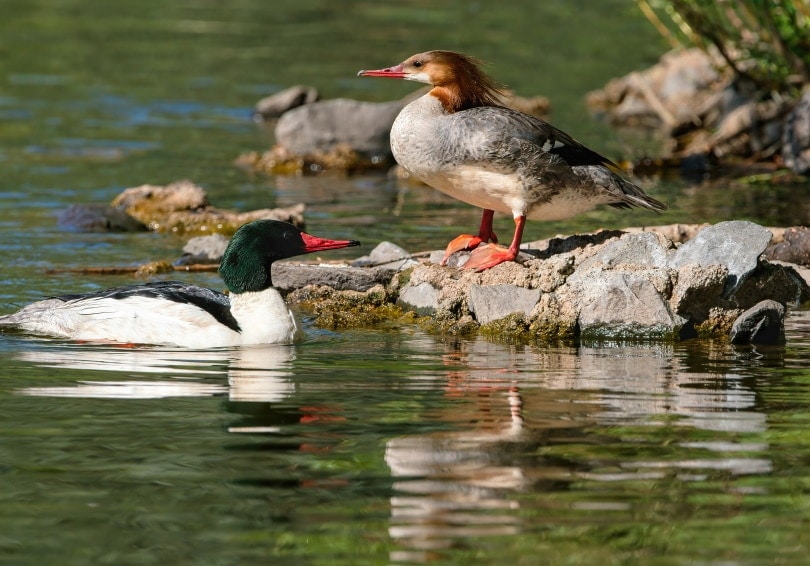
The Common Merganser is an elegant bird with the black head of the male with its bright orange bill. On the other hand, the female looks like it’s having a bad hair day with its crest of uneven feathers. Fish is the main food for this diving bird. The serrated edge of its bill helps it hang onto the prey it catches. That helps to explain one of its nicknames, sawbill.
19. Red-Breasted Merganser (Mergus serrator)
https://www.instagram.com/p/CqU_hc0Ot7L/
The Red-Breasted Merganser resembles the previous species. Both the male and female have the crazy-looking crest. This bird prefers cooler climates and will migrate through Minnesota on its way to Canada to breed. It also feeds primarily on fish. That explains why this duck doesn’t suffer from the hunting pressure of other waterfowl. Its meat tastes, well, foul.
20. Hooded Merganser (Lophodytes cucullatus)
https://www.instagram.com/p/CYMB8gPrq-l/
The crest of the Hooded Merganser makes this bird unmistakable. Both males and females have one, although the drake’s is an elegant black and white. This duck breeds throughout most of Minnesota. It is a cavity nester that prefers small streams and ponds for its habitat. Like the Canvasback, it may also lay its eggs in the nests of other ducks.

Accidentals
Sometimes, birds deviate from their regular migration routes and travel in places well off the beaten path—literally! You won’t find them on the bird list for an area or state. Instead, one may enter a space, giving birdwatchers looking for a lifer a reason to jump for joy. The word usually gets out quickly so that anyone who wants to add a species to their life list has the chance to do so. Minnesota is no exception.
- White-Winger Scoter
- Black Scoter
- Surf Scoter
- Oldsquaw
- Common Eider
- Harlequin
- Barrow’s Goldeneye
Bear in mind that related species, such as loons, coots, and grebes, are not ducks technically. While they may behave and look similar, they are different genera and species than the quack-quack birds.
Related Read: 17 Types of Ducks Found in Oregon (With Pictures)

Conclusion
Ducks are fascinating birds to watch. They offer an excellent opportunity to observe the social relationships and behavior of these animals. While you can’t get too close to some species, a spotting scope or binoculars will give you a bird’s-eye view of life from an avian point of view. After all, nearly 13 million birdwatchers can’t be wrong.
Featured Image Credit: Pixabay
Table of Contents
- The 20 Duck Breeds found in Minnesota
- 1. Mallard (Anas platyrhynchos)
- 2. Wood Duck (Aix sponsa)
- 3. Gadwall (Mareca strepera)
- 4. Northern Pintail (Anas acuta)
- 5. Blue-Winged Teal (Spatula discors)
- 6. Green-Winged Teal (Anas carolinensis)
- 7. Cinnamon Teal (Spatula cyanoptera)
- 8. Northern Shoveler (Spatula clypeata)
- 9. American Black Duck (Anas rubripes)
- 10. American Widgeon (Mareca americana)
- 11. Lesser Scaup (Aythya affinis)
- 12. Greater Scaup (Aythya marila)
- 13. Common Goldeneye (Bucephala clangula)
- 14. Canvasback (Aythya valisineria)
- 15. Bufflehead (Bucephala albeola)
- 16. Ring-Necked Duck (Aythya collaris)
- 17. Ruddy Duck (Oxyura jamaicensis)
- 18. Common Merganser (Mergus merganser)
- 19. Red-Breasted Merganser (Mergus serrator)
- 20. Hooded Merganser (Lophodytes cucullatus)
- Accidentals
- Conclusion
About the Author Robert Sparks
Robert’s obsession with all things optical started early in life, when his optician father would bring home prototypes for Robert to play with. Nowadays, Robert is dedicated to helping others find the right optics for their needs. His hobbies include astronomy, astrophysics, and model building. Originally from Newark, NJ, he resides in Santa Fe, New Mexico, where the nighttime skies are filled with glittering stars.
Related Articles:
Monocular vs Telescope: Differences Explained (With Pictures)
10 Types of Hummingbirds in Arkansas (With Pictures)
8 Types of Hummingbirds in Nebraska (With Pictures)
5 Types of Hummingbirds in Idaho (With Pictures)
3 Types of Hummingbirds in Mississippi (With Pictures)
8 Types of Hummingbirds in Kansas (With Pictures)
5 Types of Hummingbirds in West Virginia (With Pictures)
5 Types of Hummingbirds in Ohio (With Pictures)
